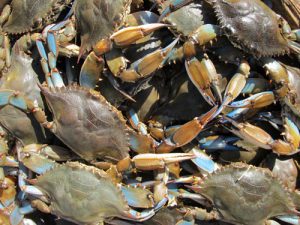
A recent winter dredge survey by Maryland and Virginia scientists provides important clues regarding blue crabs in the Chesapeake Bay.
2017 Winter Dredge Survey Results
The results of the 2017 winter dredge survey show the total population of blue crabs in Chesapeake Bay fell a bit, by 18%, due to a decline in the number of juvenile crabs, but remains at the 11th-highest level ever recorded.
This year’s female spawning stock increased by 31%, from 194 million to 254 million crabs, which surpassed the scientifically recommended target of 215 million spawning female crabs and remains well above the minimum safe threshold of 70 million crabs.
The adult male stock fell by 16%, from 91 million to a still-substantial 76 million.
However, the juvenile abundance plummeted by 54%, from 271 million to 125 million, which is the fourth-lowest level on record.
The Chesapeake Bay Stock Assessment Committee (CBSAC) is reviewing the new survey results and will release their full analysis in the 2017 Blue Crab Advisory Report this summer.
During the annual survey, scientists employ crab dredges to sample blue crabs at 1,500 sites throughout the Bay from December through March.
The winter dredge survey is the primary assessment of Chesapeake Bay’s blue crab population. Since 1990, the survey has been conducted annually by the Virginia Institute of Marine Science (VIMS) and the Maryland Department of Natural Resources (DNR).
The annual advisory report is used by managers as they review and update fishery regulations. The Chesapeake Bay blue crab fishery is managed cooperatively by Maryland, Virginia and the Potomac River Fisheries Commission.
sources: Virginia Institute of Marine Science, Maryland Department of Natural Resources
Leave a Reply
You must be logged in to post a comment.